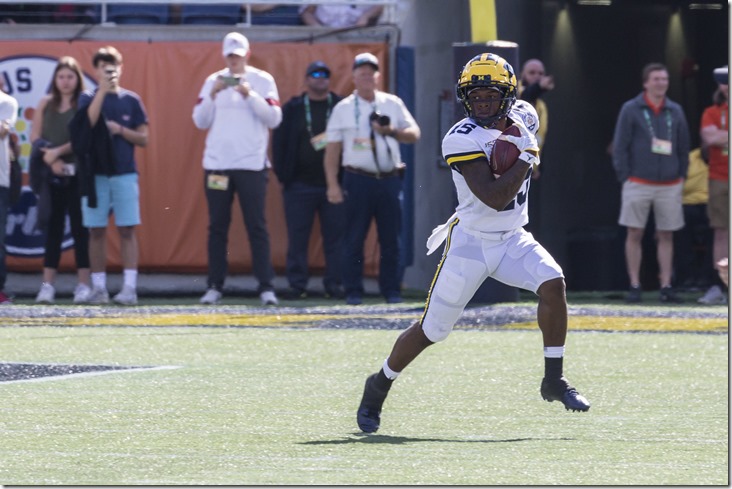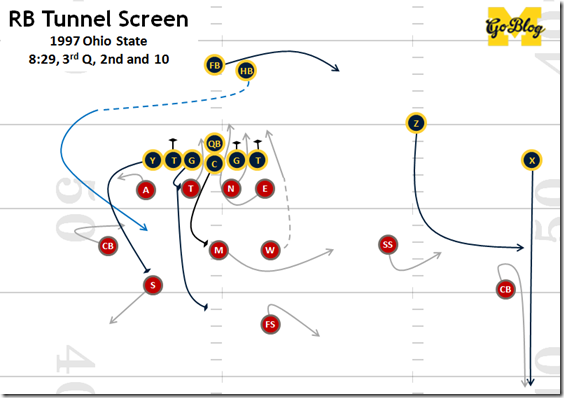screens

Previously: The Story. Podcast 12.4A, 12.4B, 12.4C. Quarterback. Running Back. Wide Receiver. Tight End. Interior OL. Offensive Tackle. Defensive End. Defensive Tackle. Linebacker. Cornerback. Safety. Special Teams.
1. Can we have some speed in space this time?
give it to the atom [Patrick Barron]
Probably. Last year's edition of this post went to a lot of trouble projecting what Josh Gattis's offense would look like based on the scraps Michigan provided in spring:
Michigan did mix in a number of plays that hinted at an evolution of last year's arc read system and a new frontier in misdirection and wide plays. … [this looks like] what Michigan's going to try to do on the ground:
Reads. Two of these plays are genuine post-snap reads, and many more were sprinkled throughout.
Edges. Michigan threatens the edge on all these plays. The split zone that kicks it off freezes the playside DE because McCaffrey is a threat to keep and the arc is a threat to have that keep go a long way. A stretch naturally tests your edge. Then a speed option and the capper: threatening one edge and attacking the other one.
Tight ends. Gattis has the offense but he's not sticking his fingers in his ears and shouting "na na na." Warinner and Harbaugh have their influence and you can see it in this package. Michigan's 2TE packages gave them an absolute ton of stuff they could do with arc games last year—more even than you may remember, because there were a number of plays that were there tactically but weren't executed because of a lack of familiarity. It looks like Michigan is building on last year's arc game.
Very little of this actually happened in the first half of the season. The quarterback refused to keep the ball on zone reads. Tight ends were extant but their involvement was muted compared to the 2018 offense, in which Sean McKeon may have been Michigan's most critical run blocker. Michigan threatened some edges in the opener by adding a pitchman to their arc package, but then that went away with nary an actual pitch.
[After THE JUMP: Gattis as Jalen Mayfield]
In the Kindle Edition of HTTV for this year (oh by the way that exists) I added a sidebar/article on Michigan State's defense and different ways to attack it. With Quarters coming back into vogue to combat the spread, and Quarters teams getting super-aggressive against the run, offenses have been pulling the old Spurrier trips-and-triangle stuff to attack it. But Quarters is not new, and there are some other good answers out there for an overzealous defense from the two-back offenses that dominated the '80s and '90s.
Here's an oldie but a goodie, the Tunnel (or Jailbreak) Screen to a running back:
A-Train motioned out to the flat, essentially becoming a receiver. Chris Floyd stayed in as an Ace back, then he drifted out the other way to draw people away from where Thomas is going. DeBord caught the Buckeyes in one of TENUTA!!!!'s crazy blitzes that overloaded the backside. The running backs flying out horizontally pulled the linebackers out of the middle. Then Thomas cut back in, and by the time the outside guys can react to that there's an A-Train a-comin' with a lead blocker. It's a race between him and the flat defender for ALL the yards. Flat guy won.
(And Tuman got away with a hold).
This play never went away; they run tunnel screens out of spreads all the time with receivers coming in. Whereas bubble screens attack the defense in the space outside, tunnel screens get the defense moving hard one way to defend the edge, then pass it to a good athlete coming the opposite direction. Like a cutback run, if the screen target can accelerate downfield before the defenders can reverse momentum and converge, it could be a huge gain.
DeBord brought that out in '97 because OSU was blitzing guys off the edge. In 2011 vs MSU Borges (unsuccessfully since he didn't have the personnel) tried to make it a hot read to Vincent Smith. It's particularly good to run against a defense that's getting upfield too aggressively and dropping other guys back, since it attacks the space between them. As you might have guessed, if you catch the linebackers blitzing too that space could be huge, which is why this is fun to run on passing downs.
* [Moore was technically a free safety in '97 but the way OSU played twins this game was to have the CBs follow their receivers and leave Moore the strong side overhang DB.]
[After the jump: Harbaugh's version]
[Fuller/MGoBlog]
“What’s happening today? Anything good? Who’s got a good question?”
/Siri goes off on someone’s phone; “I’m not sure what you said there.”
“Obviously Siri does not have a good question.”
MGoQuestion: You guys threw a fullback wheel route to Sione Houma, and it looked like it had some similar elements to the one Michigan State ran against you earlier this year. How often do you guys look at something an opponent ran, take similar elements, tweak it, and put it in the playbook?
“Well, I think that you are constantly looking at what other teams do. You’re looking at what defenses you’re going to see and how they compare to the defense that either you play or other teams play. Sometimes there’s just times where you’re gonna go look and you’re gonna say, ‘Hey, are they in this coverage during this time?’ or ‘Is this a team that runs similar type looks?’ Ball plays are stolen all the time from everybody and everywhere.
“You’ll see very often you can turn on plenty of games and say, ‘Boy, didn’t they just run this?’ or ‘Didn’t Michigan just run that?’ or ‘Didn’t Seattle just run that?’ or whoever it might be. It’s just constantly- you’re always looking and watching film and when good ideas or things that look like we could use, you always try to use them.”
Is Jake [Rudock] getting more freedom from you guys to make decisions in terms of plays than he had earlier in the year?
“No, I think he’s really just getting more aware of the entire system rather than half of it or three-quarters of it, so the more he’s aware of what we’re trying to do, the more he can get to certain guys faster or maybe where he can get rid of the ball quicker. He can hold the ball longer knowing that something’s picked up where maybe early on in the season he might have thought the protection scheme might not have known that it was picked up, so checked it down quick.
“There’s, I think, more just knowledge base, and as knowledge base grows you become more comfortable, and when you become more comfortable maybe it feels like you’re getting to different things but you’re really just going through and maybe early in your career as a rookie quarterback or first year in our system quarterback you can go 1-2-checkdown. Now maybe he feels good enough to 1-2-3-checkdown or 1-2-3-4-checkdown. I think you see it in the NFL with rookies to their second year. I think you [also] see it with guys throughout the season.”
Jim credited you with the screen game. Can you talk about how that’s coming along and how pleased you are with it?
“Everybody gets credit for that. It’s really- the whole screen game, I believe that you can get a lot of yards in the screen game, and if everybody is on the same page with it we can get different ways of doing it, different formations, different guys catching screens. I think you go get some gimmee yards at times, but then there’s also times when screens are called and they don’t look good [and] it’s just a ball thrown right at the dirt, so you gotta be careful about that with screens. But, nah, I mean, I know he said that but it’s everybody has everything to do with our screen game and it’s just one of those deals that we ran a lot of them at different places where I’ve been and have really enjoyed the different aspects of it. You know, you can be real creative in the screen game. It’s not always just a straight drop-back deal.”
[After THE JUMP: Jake Rudock might be 53 years old, no one really knows]



42